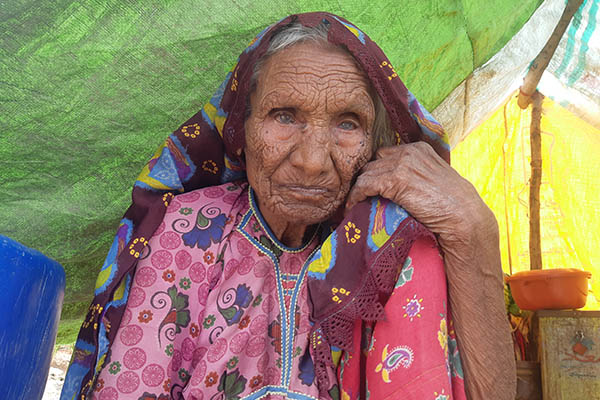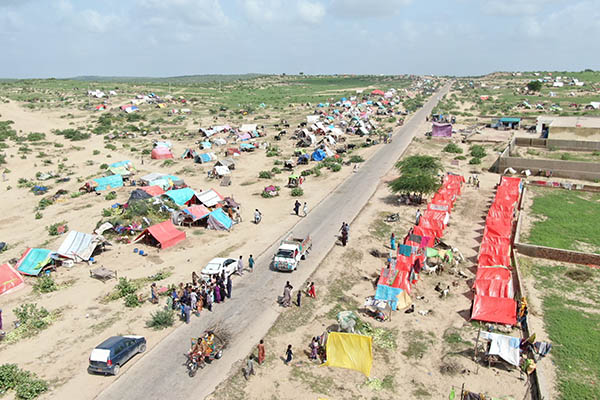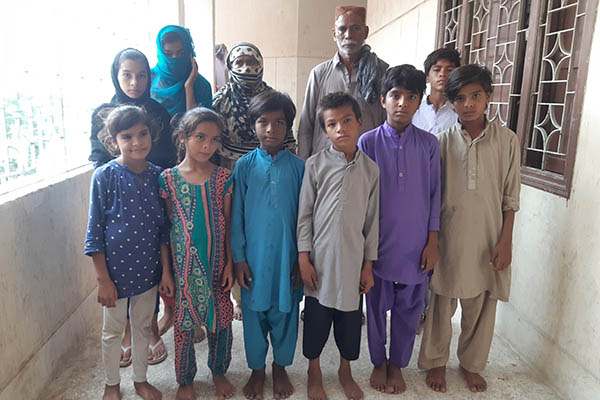
An elderly woman waits at a flood relief camp in Umerkot on Aug. 28. Photo by Zulfiqar Kunbhar
Record rains—by some estimates more than 500% the annual average—hit the lower riparian Sindh province of Pakistan this year, exposing the country’s fault lines regarding its preparedness for global warming, despite multiple warnings that it is the eighth-most vulnerable country in the world to the devastating impacts of climate change.
Pakistan’s politicians often cite the country’s vulnerability to climate change as a major concern. This awareness has, however, rarely been reflected in government policies, with the Sindh government failing to ensure that natural waterways that funnel floods to the Arabian Sea are kept free of encroachments. Over the course of multiple monsoon spells since mid-June, this arrogance has proven fatal for hundreds, as district after district fell victim to flooding, forcing hundreds of thousands to evacuate their inundated homes, placing incredible strain on the province’s social fabric.
“At the moment 5-6 feet of rainwater is standing in an area of Sindh spanning 250,000 square kilometers,” Muhammad Qasim Soomro, a member of the Pakistan Peoples Party that rules Sindh told Pakistan Standard. “There is encroachment on water ways. All water ways are almost occupied,” said the lawmaker, who is also a member of the provincial Standing Committee on Law and Parliamentary Affairs and Human Rights.
Dr. Ghulam Rasul, former director-general of the Pakistan Meteorological Department (PMD), likewise lamented the presence of encroachments in the middle of the Indus River. The traditional waterways, he stressed, should be restored to avoid such calamities in future. Sounding the alarm over river flows from the country’s north, where rains have also been far in excess of normal, he warned river-flows from Punjab and Khyber-Pakhtunkhwa would likely reach Sindh by October—the traditional time for sowing of wheat in the province—stressing this could mean flooding would hamper the growth of future crops in addition to destroying current stocks.

An aerial view of the flood relief camp in Umerkot, Aug. 28. Photo by Zulfiqar Kunbhar
Massive losses
Official data shows Sindh’s rainfall during the 2022 monsoon was around six times higher than its three-decade average. Till Aug. 29, the province received 697.1 millimeters of rain against its 30-year average of just 123 mm, says the National Disaster Management Authority (NDMA), a federal agency tasked with responding to natural disasters and their mitigation. According to its records, 1,136 people died due to various rain-related incidents across Pakistan between June 14 and Aug. 29, with 402 in Sindh alone.
Similarly, per the NDMA, rains have damaged 5,063km of roads across Pakistan, of which 2,328km were damaged in Sindh. In addition, 1,051,570 homes have either been damaged or destroyed across the country, with Sindh once again comprising the bulk of the number at 884,597. Of the province’s 30 districts, 23 have been declared calamity-hit by the provincial government.
In total, this year’s rains have impacted 33 million people across Pakistan—14 million of them in Sindh; the total population of the province is estimated at 47 million. Sindh is also the country’s second biggest agriculture producer, cultivating around a third of the country’s total agricultural output. According to Sindh’s Agriculture Extension Department, the total losses to the province’s agriculture output due to the rains has been estimated at Rs. 335.44 billion.
“Leading damaged crops are cotton and dates, whose 100 percent cultivation area has been impacted,” Ali Nawaz Channar, technical director of Agriculture Extension Department told Pakistan Standard. “Other crops are rice with 71 percent damaged area (nursery area included) and sugarcane with 21% damaged area,” he said. “The situation is similar for remaining crops, including sesame with 25% damaged area, kharif vegetables with 54% damaged area, tomatoes with 52% damaged area, chilies with 68% damaged area and onions with 49% damage area,” he added.
Looming food insecurity
Experts on food security already sounding alarms over the damage to crops and livestock impacting Pakistan’s food supplies, triggering further inflation in the weeks and months to come. “Crop and livestock damages are huge. Inundated standing crops will die by suffocation in a few days. This will affect cash crops like cotton, sugarcane and rice. Damages to vegetable crops would affect supply across Pakistan, resulting in prices of kitchen items going up,” Aamer Irshad, head of Program Pakistan at the United Nations’ Food and Agriculture Organization (FAO) told Pakistan Standard.
The FAO official said the news was no better for livestock. “Some animals died, which is a direct loss to poor farmers. Fodder supplies will also suffer, making animals weak and vulnerable to disease outbreaks like FMD, LSD and PPR. This will affect animal-based food supplies and cause inflation,” he warned.
Growers in Sindh believe some of their crops might still be salvageable, and blame the slow dewatering process—many areas have been underwater for weeks—for causing further harm. “As per our estimates 95% of Sindh’s cultivable land has submerged,” said Syed Nadeem Shah Jamot, vice-president of the Sindh Abadgar Board, a platform that represents growers of the province. “If dewatering is not done promptly then Sindh will miss at least 50% of its target for the upcoming Rabi season crops of wheat, mustard sunflower, canola and lentil crops,” he stressed. “That will cause serious food insecurity problems, considering we have already lost rice cultivation on a large scale,” he added.

Allah Warayo and family fled heavy rains in Qambar to reach Karachi, where they are currently housed at a relief camp. Photo by Zulfiqar Kunbhar
Mass migrations
As areas across Sindh have been flooded, homeless migrants have started to make their way to provincial capital Karachi, which has suffered heavy rains but has fortunately remained free of standing water thanks to government efforts.
Allah Warayo, a 60-year-old farmer, reached Karachi from Qambar—a distance of 450km—alongside his 19-member family. “Our area came under flood water. So we saved our family, escaping here and came under this shelter,” he told Pakistan Standard. “This flood has brought people on roads from all over Sindh. Our rice crops are totally submerged. Our houses have fully damaged. Rains have washed away our livelihoods,” he said from a school in Karachi’s Sachal Town, which has been designated a rain victims’ relief camp.
“This is canal flooding,” he lamented with tears in his eyes. “Traditional routes for water drainage are already filled. So how will water recede?” Pleading to the government to provide all flood victims with safe sites to call home, he stressed that all they want is to resume their livelihoods so they can feed and guard their families.
Another migrant, Abdul Hameed Bambal from Jacobabad’s Thul area, arrived in Karachi one week ago, covering 550km. A teacher at a madrassa as well as a farmer, he said he did not expect the water to recede any time soon. “As our area drowned, we arrived here and will search for some work to make a living,” he said. “[Our] madrassa has also closed. We don’t know when the water will recede; the rains just won’t stop,” he said.
The way forward
The Sindh Abadgar Board’s Jamot has demanded the government expedite dewatering, adding it should also provide farmers with engines and pumps to speed up individual recovery efforts. The government, he said, also needs to manage the natural waterways to facilitate the flow of water. “There are some districts where the drainage system does not exist at all practically. Sindh’s growers can only sow wheat after there is dewatering. At least for the next three months I don’t see any cultivation,” he regretted.
With the Rabi crop looming, he said the government must facilitate flood victims by providing fertilizers and quality seeds of wheat, sunflower, and mustard oil, either free or at subsidized rates. It should also, he suggested, waive off agricultural loans taken for the ongoing season’s crop, as well providing interest-free loans for the Rabi season.
Lawmaker Soomro, meanwhile, said “revolutionary steps” were needed to prepare for future climate change events. “There is little to no realization about climate change adaptation at the administrative level. We are not prepared, we are not accepting it,” he lamented. “This is old thinking that water will recede only into Arabian Sea via River Indus. We need to think out-of-the-box. We need to shed water using technology like GIS, satellite images. In the long term we need to shed water and create ponds at deserts,” he added.
Rasul, the former head of PMD, believes the country must accept that climate change is here to stay and adapt to it, rather than try to fight it. “Climate change could be a blessing or disastrous—it is up to us how we adapt,” he told Pakistan Standard. “It was important to convert climate change challenges into opportunity. We need to do long term management planning to deal with this level of rain water as due to climate change this sort of extreme weather is likely to be frequent,” he stressed.
Warning that the next battleground would be water, he said climate change would cause water availability to seesaw between “too much” and “too little.” This was an opportunity, he said. “Water is capital and more precious than gold and money. The nation with the capacity to store water will benefit, while the nation without would be in trouble,” he warned. “This rain’s volume could have been a blessing to improve the groundwater table. Had there been proper infrastructure, the area could have taken more benefit of this,” he added.
Kunbhar is Karachi-based freelance environmental journalist. He tweets @zulfiqarkunbhar
